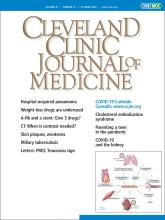
We are well past the hypothesis stage in recognizing that inflammation plays a seminal role in the development and expression of atherosclerotic vascular disease (ASCVD). The hypothesis has matured into a model where clinical trials are being conducted that may ultimately home in on defining specific anti-inflammatory strategies that will augment our current lipid- and thrombosis-directed therapies in limiting the occurrence of cardiovascular events. A specific monoclonal antibody inhibitor of interleukin 1 beta (IL-1 beta) has been shown to modestly reduce cardiovascular events. Weekly methotrexate in doses used fairly successfully in patients with rheumatoid arthritis was ineffective, whereas colchicine may have benefit in preventing atherosclerotic events. The mechanism or mechanisms of action of these latter two medications are incompletely understood, although it is believed that at least part of colchicine’s efficacy in treating gout is due to suppression of crystal-induced generation of IL-1 beta. The message seems to be that the model is correct, but specific proinflammatory targets still need to be identified.
These studies and the inflammatory concept of ASCVD have focused on the vascular atherosclerotic plaque, a complex physical structure involving and engaging in a dynamic way many cellular and soluble players, as well as being affected by rheologic factors. But even “simple” cholesterol-based structures—cholesterol crystals and some lipoproteins—have pro- and anti-inflammatory activity that can be clinically relevant. Perhaps when we understand better the response to cholesterol crystals, we will be even better able to manipulate the more complex plaque.
A syndrome that likely occurs (in a mild form) more commonly than we diagnose it is cholesterol embolization. Cholesterol crystals, which may be visualized histopathologically as vascular-occluding clefts, break loose from large-artery endovascular plaques and flow downstream until their flow is limited by luminal diameter. This embolization seems most often triggered by mechanical iatrogenic disruption by catheterization, but not always. Notably, the clinical course of cholesterol embolization syndrome is not the same as that of thromboembolism. The latter tends to present as an acute, rapidly developing event—stroke, myocardial or renal infarction, or foot or digital ischemia with often fairly rapid onset of tissue necrosis. This is likely due in part to the larger size of the occluded artery, as well as to the rapidly progressing thrombotic reaction that is triggered. With good timing, skill, and a little luck, this may respond well to thrombolysis, anticoagulation, thrombectomy, or a combination thereof.
But the cholesterol embolization syndrome behaves differently, which is why we may miss milder cases, and why, when more pronounced, it may superficially or convincingly mimic other vasculopathies, including some forms of vasculitis.
The cholesterol clefts and debris tend to lodge in smaller arteries and arterioles and not cause acute large infarctions with necrosis. The clinical course is often subacute over days to weeks with a staccato progression. It has been postulated that this is due to showers of the cholesterol emboli over time, but fitting with what we now more fully recognize about the phlogistic properties of cholesterol structures, it may also be due to an inflammatory response that evolves over several days or longer, triggered by the cholesterol crystals—crystals that are more exposed than when they were buried within a vascular plaque. The more we learn about the specific response triggered by these crystals, the better able we may be to treat this syndrome and, perhaps, the plaque from whence they came. At present, the treatment for cholesterol embolization is limited to attacking the atherosclerotic process and its well-recognized comorbidities such as hypertension.
And the response to cholesterol embolization can be striking and surprising (reviewed by Ozkok1). The mechanical occlusions of arterioles and small deep cutaneous, fascial, and muscle arteries can cause livedo. But in addition, the crystals or the embolization process often trigger the acute-phase response with elevations in fibrinogen level, sedimentation rate, C-reactive protein level, and occasionally fever. These findings are consistent with the experimentally demonstrated ability of cholesterol crystals to activate mononuclear NLRP3 inflammasomes that elaborate IL-1 beta. The crystals also can activate complement, sometimes to a degree resulting in measurable depression of C3 or C4 levels. The crystals can elicit the elaboration of IL-5, which results in a mild to modest eosinophilia, and in the kidney may result in the diagnostically useful finding of eosinophiluria if a special stain (Hansel stain) is used with urine microscopy. Mild thrombocytopenia may also occur, which is diagnostically helpful in suggesting the embolization syndrome as opposed to a primary vasculitis syndrome such as polyarteritis nodosa. The latter can also cause livedo, an acute inflammatory response, slowly progressive renal dysfunction with a fairly bland urinalysis, and hypertension. Thrombocytopenia is not expected with a primary vasculitic syndrome (although eosinophilia may occur in some).
The general message from this discussion, and from the patient presented by Smith et al in this issue of the Journal (page 605) is that even in a patient with known significant ASCVD including peripheral vascular disease, paying attention to the nuances of the historical presentation and some basic laboratory studies can pay off. And further understanding of the cholesterol embolization syndrome may provide insights into the mechanisms and ultimately treatment of atherosclerotic disease.
- Copyright © 2020 The Cleveland Clinic Foundation. All Rights Reserved.






